Dispatch From the Rebellion in Minneapolis
Anonymous
The following is an interview with an anonymous participant in the George Floyd rebellion in Minneapolis taken on June 1, 2020 by the French website Lundi matin. While the situation has developed considerably in the past week, with a severe uptick in counterinsurgent policing from within and without the movement, the themes touched upon in the interview allow it to speak beyond the immediacy of its immediate moment in time.
Other languages: suomi, Svenska, Deutsch, Español
Lundi Matin: We were receiving bad news after bad news: the death toll in the USA was sizably larger than in other countries; a megalomaniac president was inciting citizens to inject bleach up their veins; militias were protesting to reopen businesses and invaded state houses with impunity; hardly anyone resisted. Then came the spark: the cruel murder of George Floyd. Are you surprised? How do you account for the uprising?
Yes, in a way the uprising was completely unexpected. After the revolutionary movements all over the world in 2019, personally I was afraid that the pandemic would throw us into a new dark era. But just when we all lost hope, America showed the world that nothing is over. There are also a lot of clear reasons why it happened the way that it did. To start with, because of the COVID-19 pandemic and quarantine measures, people overall are much more plugged into the internet than before. The video of George Floyd’s murder was able to spread at a bigger scale and more quickly than these things usually do, and the same goes for news of the protests being planned. Months of being deprived of the crowd experience, of human touch, certainly contributed to the unpredictable character of the uprising. I think people are just really exhausted, from the pandemic, but moreover from centuries of institutional anti-black racism and oppression gone unchecked. People have protested for justice for years, and gotten nowhere. It shouldn’t be a surprise that eventually people gave up pleading, and began to fight back.
Tell us your feelings, how did the day pass? How was a collective intelligence built (or not!)? What the people are saying, or not, about the uprising? What claims are being made? Any local variations? What kind of things happened?
I’m not entirely sure people outside the region understand the scale of what has happened. The first day already covered over two miles, between where George Floyd was murdered (38th & Chicago) and the Minneapolis Police 3rd precinct (Lake & Hiawatha). Multiple crowds made their way between these two locations, often with zero police presence whatsoever. The clashes were focused around the precinct, but things were getting out of control in the general area too. By the end of the second day, riots and looting had spread for miles in basically every direction. While the police were unable to advance much further than the immediate area in front of their precinct, crowds wandered in different directions, breaking into stores, writing graffiti, setting fires. Some people drove to different neighborhoods to loot stores in small groups.
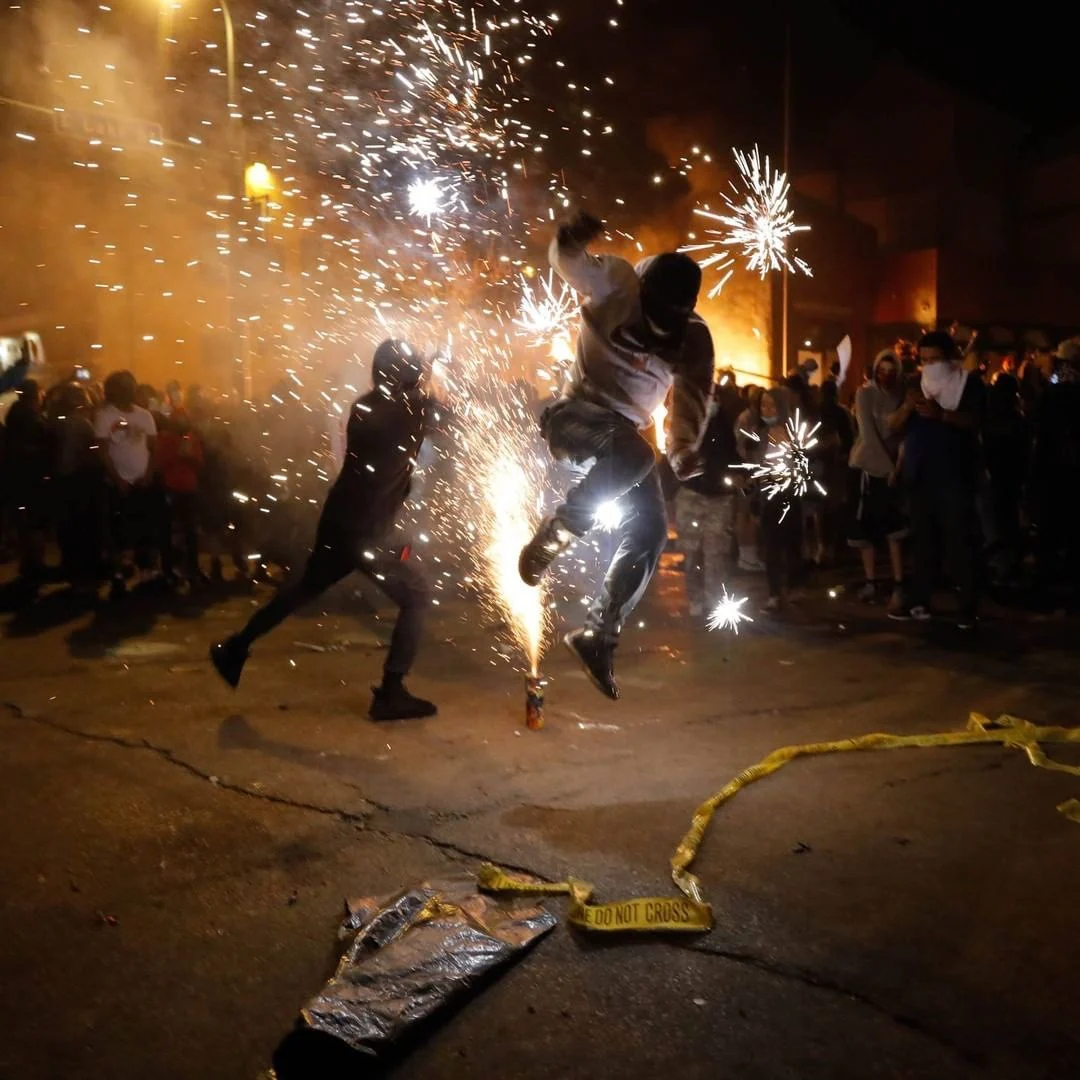
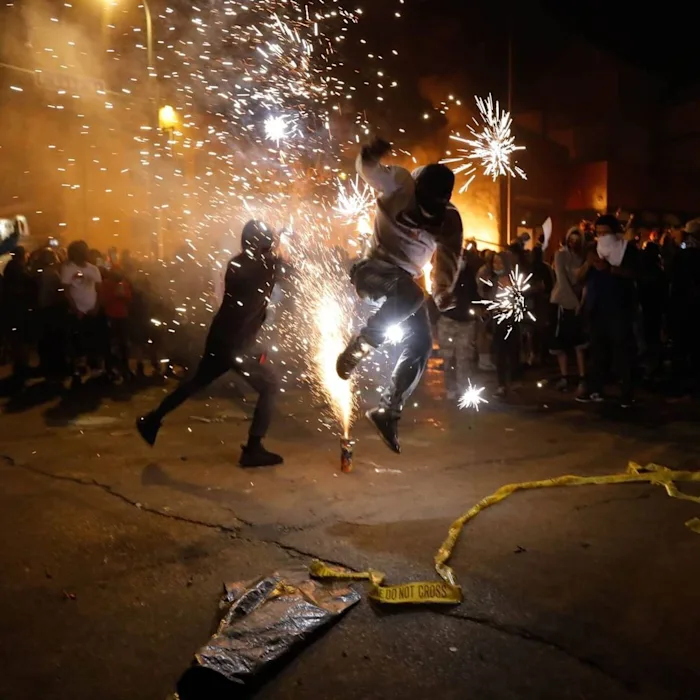
On the third day, spontaneous crowds began looting stores midday in Saint Paul (Minneapolis’ twin city) and, later in the night, as the police were forced to retreat from their precinct, other groups were looting across town. When reinforcements from other law enforcement agencies and the National Guard arrived that night, they retook the area around the 3rd precinct. The next day, with very little prompting, crowds began to assemble over at the 5th precinct, which is almost two miles down Lake Street. Again, crowds roved around the entire area and police were mostly only able to defend the area immediately around their station.
All of this is simply to illustrate that there was no spatial limit to what was happening, it was all over both cities and beyond them. There was the incredible collective intelligence to simultaneously concentrate police forces in their precincts, while also diffusing around the district and refusing to be contained.
If you want to know the wildest thing I saw, it was someone driving a stolen post office van full speed into the barricades in front of the empty police station, before setting it on fire. Later, we saw people walking out of the banks with a safe and bags of cash. There’s also stories of teenagers in fast cars looting multiple diamond stores in Union Square in San Francisco on Friday night, with the police chasing them but failing to catch them. People fly from all over the world to shop in that district. What we are witnessing is the largest downward re-distribution of wealth in modern US history. I think that’s pretty wonderful.
What happened with the execution of George Floyd has been a national, even global affair, as people in many countries are monitoring the situation. It’s not surprising that demos happened all across the USA, but it seems like the intensity and the determination of the protesters of other towns have been comparable to those in Minneapolis. Why? Is this a big city movement, or is it a countryside movement also?
It’s absolutely incredible that people in so many other cities are joining the uprising, and that it has taken on such a militant character everywhere. It is also not limited to big cities—Minneapolis itself is not such a big city already, compared to New York or Chicago. Not only have many other medium and large cities risen up, but riots have broken out in smaller towns all over. So much has been happening locally it has been hard for us in Minneapolis to pay close attention to what is happening elsewhere.
It’s hard to say why it has reached such an intensity in other cities too. Because everyone everywhere is sick and tired of police violence? Because everyone wants to be in a crowd of people again? Because everyone is watching their phones and can see how easily we have forced the police to retreat? There is probably a Marxian analysis that would point at the unemployment numbers because of the pandemic, with the increased precarity it has led to. This is certainly an element too.
It’s hard to say if the movement will reach the countryside. There’s significant examples of actions in small towns like Fayetteville, North Carolina, where an old slave-auction house was burned. Cities are being burned because, especially after the pandemic, people know how hostile these places are. It’s hard to say how the counterrevolution will re-format the city. The police have failed to impose their curfews, which were standard for the pandemic. On the other hand, Minneapolis Police have already announced they will use ‘contact tracing’ developed during the quarantine to surveil and repress demonstrators. We can expect an unprecedented wave of repression to follow.
Is there any inspiration from other context? Hong Kong, the Yellow Vests or otherwise? Is there a circulation of tales and experience?
The uprising in Hong Kong seems to have had a real impact on the uprising here, along with the more general experience of global unrest of the last years. People have circulated tips on extinguishing tear gas that was demonstrated in Hong Kong, they’ve taken up “be water” as a strategy to avoid being concentrated in only one spot, and lasers are being used to blind the police and force helicopters to retreat.
The Twin Cities have seen smaller uprisings against police murders in the past as well. In 2015 in north Minneapolis and 2016 in Saint Paul. Tactics that were first explored in these moments, most notably perhaps would be trapping the police inside their own precinct in 2015, have become common sense. This, paired with the general tactical intelligence that has permeated around the world in 2019, helps define the strategic sensibility of the uprising.
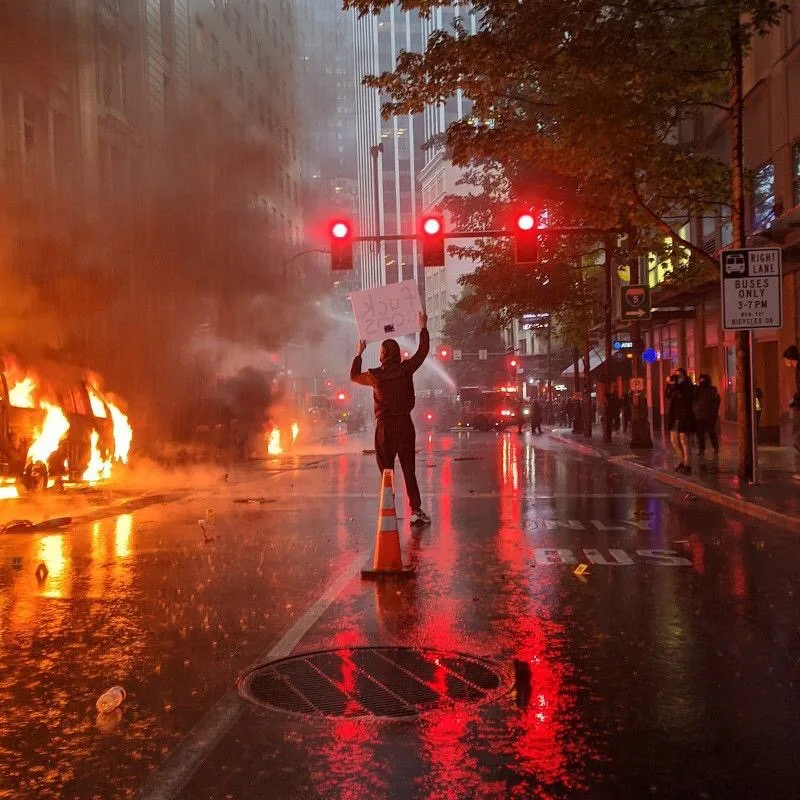
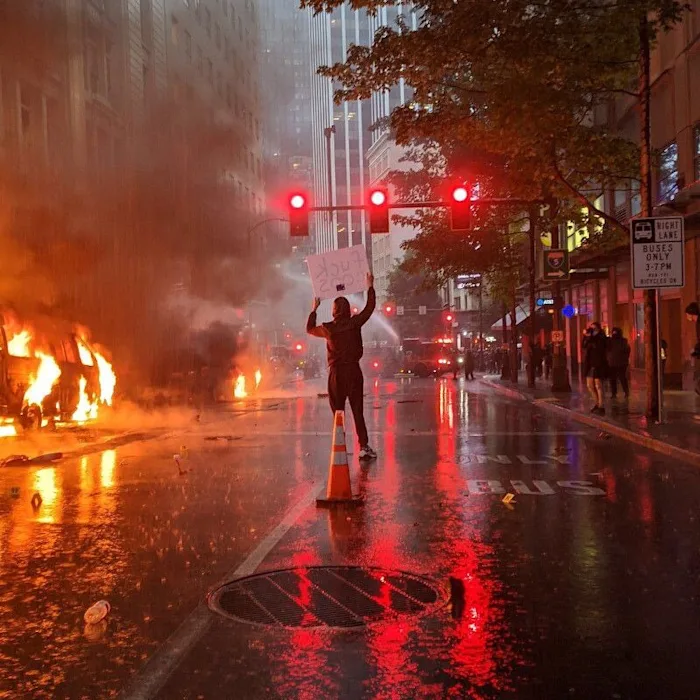
I would even say that on a tactical level, the intelligence being built has synthesized ‘be water’ with several important additional elements, such as cars, guns, and arson. The widespread and decentralized looting all over both Minneapolis and Saint Paul, much of it done by groups of people in cars, forced the police to spread their forces in every direction. So people would loot and destroy stores like Target and Walgreens and then move to a different location. In response, the police would then have their officers stationed outside of looted businesses like Taco Bell or Target to protect them from being set on fire, and this meant that there was not enough police to guard the 3rd precinct (which got burned). The tactics are quite simple: loot every store and burn as many of them to the ground as possible. The cops spent much of their time chasing fires, and were outpaced by the demonstrators. So the police stood on the roof of their precinct and could only defend themselves with tear gas. When they ran out of tear gas, they were forced to flee the building under fear of attack. Demonstrators then looted the building and set it on fire.
The crowds in Minneapolis were distinctly young people, though there was a lot of support from older people as well. In fact it’s been interesting to see how the riots have worked without strict unity, how many people stood alongside each other even if they didn’t agree about everything.
Who is organizing the demonstrations currently unfolding in the most important American cities? How do they occur? Do they come from preexisting activist networks, or are they mostly spontaneous?
In Minneapolis, there have been almost no organized protests happening. The very first day was organized by coalitions of Left groups, but they were not leading anything whatsoever. Many people in the marches organized by leftists were trying to doxx people doing anything subversive in the marches, so I think most people did not feel safe participating in the “peaceful protests”. Aside from these minor protests, people just knew that they could go to the 3rd precinct and find a crowd. While some might have announced this or that ‘protest’, our sense is that the crowds that really mattered were largely spontaneous and not responding to the organizing done by leftist groups. I imagine that in most cities, some demonstrations have been called by left-wing activist groups, but the unrest quickly outpaces them. Already, the left has begin to cannibalize the insurrection and turn it into a new campaign for reform, but it’s clear that this won’t work very well.

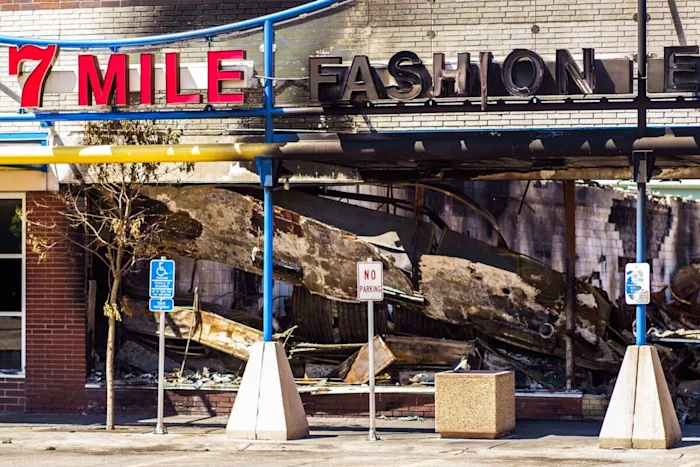
Could you tell us about the atmosphere during these demonstrations and riots, both in terms of composition and in terms of emotions? Here in France we hear that the riots are pretty diverse, which also allowed the police and many politicians to lay the blame on white “infiltrators”. We heard that people were driven by grief and anger—are these the principal emotions that lead people to go out in the streets?
The uprising has had a very diverse character. It has been multi-racial, which reflected the south Minneapolis neighborhood around which it centered. It was only after the first four days that the government began saying that the violence was started by white supremacist infiltrators that paranoia began to spread within the crowds. The idea of white infiltrators being responsible for the violence is itself an old racist ploy, and thankfully has so far not been very effective.
Emotionally, yes, grief and anger of an unparalleled magnitude are the driving motivations of the uprising. But when the police are pushed out and people are openly looting or building barricades, there is also a very joyful and festive atmosphere too. I don’t see this as a contradiction—people are angry at those who oppress them, but are also feeling, perhaps for the first time, the power of acting together with thousands of others.
I will never forget the people I met around the large bonfire that was the third precinct on Thursday night in Minneapolis. Everybody was smiling and sharing looted goods, dancing and relaxing, as there were no cops in sight. If you’ve ever read the novel Dhalgren by Samuel Delany—you can imagine what it was like. Entire blocks burned while people picked through the remnants of looted buildings, fired weapons and lasers into the sky, encountered new people, and danced—it’s an especially American type of love.
Even if it’s daunting to generalize, beyond the immediate context, what is the target of the movement? Racism? Police violence? Trumpism?
This movement is the contemporary analog of Nat Turner’s insurrection in the 19th century. In America, the revolution will never begin because of austerity, over free healthcare, or for “communism”. What we are seeing on the streets of Minneapolis and all over the country is an armed insurrection against the slave owning and property owning class. Walking through the streets with entire blocks burning, you keep hearing people saying things like “500 years, 500 years” (referencing the beginning of the Atlantic slave trade). This is an insurrection against the apparatuses of racialization. So the horizon is much bigger than reform and “justice”, and I think this is really worth emphasizing, and something that would appear to set it apart from previous Black Lives Matter movements. Of course, many people are saying they want to have the police convicted of murder, and that’s fine, because it’s an almost impossible demand. But everybody on the streets keeps saying the same refrain: “Burn it all down. Blow it all up.” Nobody expects anything from the government institutions. When people resist here, they remember the last 500 years of genocide and slavery, but also 500 years of resistance.
In terms of demands, is it reasonable to contemplate a political response to these events? After six years of BLM and two Obama mandates, the situation has barely changed. And the upcoming presidential election is clearly not offering new hopes of change. What is there to hope for, according to the protestors? Is the movement opening new horizons, or is it fueled by vengeance?
Right now the media will tell you the cycle is focused on vengeance, and it definitely is. But there are many promising examples of positive horizons being set. First and foremost, people are setting up mutual aid tents all over the streets for redistributing looted water and snacks to people, and there was always a lot of looted milk people could use to clean the tear gas out of their eyes. Medics are everywhere and constantly helping injured people. This is widespread, but of course the media will never show this.
Regarding its positive horizons, we were told that schools were opening up to people who were trapped by police in Chicago last night. In Minneapolis, some people took over a hotel and moved 150 homeless people into it.
This is the first time in modern American history that a police precinct has been captured, destroyed, looted and burned. There now exists a real and concrete possibility of forcing police departments to surrender—this is something new. The fence surrounding the White House was breached on the same night, which is likewise fairly unprecedented. We don’t know what will come next, it’s really hard to say.
Revolutions in the 20th century, inspired by the Russian Revolution always imagined the process as taking place through the siege of government offices, after which a dictatorship of those previously excluded would take place, which would install a new society in place of the old one. Today, it must be admitted that we simply do not posses any image of what form of “society” will replace the current one, if any at all. Perhaps it’s just not how power works these days. As our French cousins wrote after Trump’s election: “Maybe what we’re seeing is a gradual but infinite fragmentation of the national territory – an end to the United States of America – where the multiplication of militias would necessitate the multiplication of communes.” Are we the new Americans? Who knows. Perhaps these crowds will burn it all down and pick up from where others left off a century and a half ago, by fighting against colonial invasion and slavery.
What has BLM’s role been since its creation, and what role does it have in the movement? It’s difficult from where we are [in France] to grasp whether it’s a slogan, a network, or a fully fledged political organization. Should we think of the movement and its innovations (until now mostly in the art of destruction) as a criticism of the failures of BLM, or rather as a continuation of BLM?
Black Lives Matter is basically all three of those things and the latter (organization) benefits from its confusion with the former (slogan), as it allows the organization to essentially speak for itself while at the same time being treated as if they speak for an entire movement. In the Twin Cities, there is no Black Lives Matter chapter anymore, which makes this a little easier to deal with.
That said, many people honestly appear to have given up demanding justice from the state, instead preferring to fight the police directly. Black Lives Matter, as an organization, have too often sought to canalize this rage and determination back into calls for reform and justice, as we see with the demand to ‘prosecute the officers’. There are only a minority of people demanding such actions at this point, which could be called a response to the failure of the formal Black Lives Matter. But it is this failure that perhaps allows “black lives matter” as a slogan to be put in contact with its full power.
As we’ve seen, the movement is very diverse, from young people who are respectable enough to be TV or sport stars, to looting youth. Is there dissension? If so, do they concern modes of action? Are there already leaders and organizations trying to channel collective rage?
Of course there’s disagreement, but that’s what gives the movement its power. Hong Kongers have this slogan: “each in our own way, we climb the mountain together”, which emphasizes how people can disagree and still come together to form a coherent force. I think this is the reflex that still needs to be developed within the movement: the sense that we don’t have to agree or arrive at a consensus in order to compose a revolutionary movement. I think people will learn this sooner or later, but the process won’t be pretty. There’s a lot of trust that needs to be built. This country is founded on anti-blackness, and it’s long overdue that white people start taking very serious risks to protect our black and brown brothers and sisters. That means doing a lot more than just protesting. We have to create real infrastructure to allow people to outlast the end of this world, since what we are seeing on the streets of Minneapolis is clearly the beginning of an entirely new world.
So many people feel abandoned and alone. In the USA, the COVID mortality rate was disproportionately higher for non-white community, as was also true of life expectancy more generally before the pandemic. Is there a sort of nihilism behind those destructions? Especially among the younger generations?
It’s a tricky word, “nihilism”. Perhaps their method is nihilism; but anybody who has seen these people knows they have freedom in their hearts. Perhaps its more a sort of “hopelessness”, of the sort that befits a “no future” generation. It seems almost impossible to imagine revolution in the USA, yet on the other hand, I would not call the people burning everything down nihilists. They are our only hope moving forward; without the young men and women shooting back at the police, the real horizon of collective possibility would close for all of us. Without the arsonists and looters we would be nowhere.
At the same time, it is decisive that we find ways to ensure that the movement is not transformed into a symmetrical armed conflict with the state, but I think many people know that. People have been fighting these fascist pigs for 500 years; there is a deep knowledge of resistance in America, and I think in moments like this we really see just how smart and resourceful Americans really are.
Nobody thought we could stop this shit, but there’s too many of us and the police cannot stop us. Trump can’t stop it, the left can’t stop it. All the pain, all the trauma, all the grief is right there. We have brought this country to its knees. When there are fires lit at the White House, it means the prospect of revolution has once again become real. This is only the beginning.